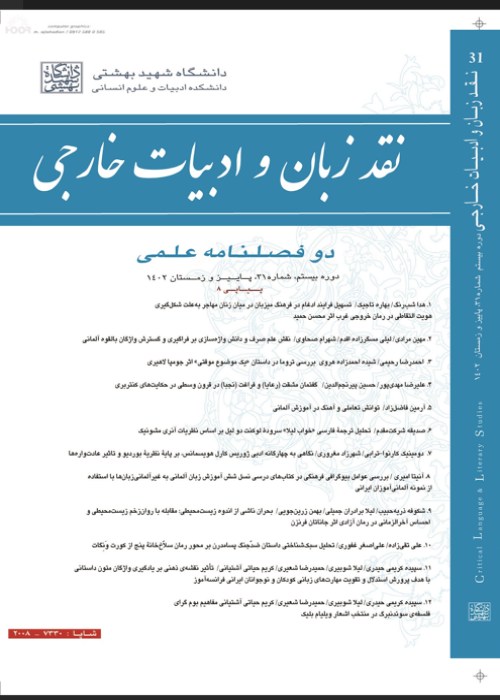A Semiotic Analysis of Tajiki Children and Adolescences Stories
Author(s):
Article Type:
Research/Original Article (دارای رتبه معتبر)
Abstract:
Introduction
Stories reflect the intellectual and cultural foundations of society and the discovering the infrastructural elements and underlying layers of story, with the aim of representing social specifications of each nation.
Methodology and Argument
This research tries to apply semiotic approach and pattern of Greimas actors in analyzing Tajiki children and adolescences stories and find out the covert cultural and social underlying in this stories and its relation with basics and general frameworks of culture and education in the given country. For this purpose, 5 stories from 100 Tajik children and adolescences story books as targeted sampling have been chosen.
Background Studies
Mohammadi and Abbasi (1380) in their study" Samad: the structure of a myth" proved the applicability of the theory in the stories by studying eight stories by Samad Behrangi according to the Greimas actors, model and providing the plots. Shairi (1381) in the book basics of modern semantics introduces various chains to account for surface structure of discourse and uses these chains in the analysis of the narration. He also by translating books such as D l imperfection and writing various articles from the point of view of the structuralism semanticians in semeiotics analysis of the discourse to liquid semiotics in books in this field tries to introduce theoretical frameworks of narrative analysis. Rahman and Karimi Ghare Baba (1387) in the article "Narratology of Short Stories of Mohammad Ali JamalZade" concluded that short stories of Jamalzade are formed in the boundary of tradition and modernism. Although Jamalzade later in1 his career was no longer an innovator and became a routine writer. Pashaii (1388) in a research "Meta-story, the Language of Thought Stimulation in Iranian Children’s Literature: a Study of Three Works by Hassan Farhad" came to this conclusion that meta-story literature by special techniques in composing the story such as inter-textuality, creating conversation among children, writer and fictional characters and funny imitation, far better than realist literature is able to motivate child thought. Hoseinzade Khozani(1389) in a research " Structural Criticism of 20 Adolescent Short Stories" tried to introduce some famous writers of children’s literature and study their works by analyzing four main elements of stories , plot, characters, sign and narrative dimensions to discover and give accounts of them. Kiani et al (1391) in a research "Theory of Reader Covert in Children’s Literature, A Case Study of the Works of Lina Kiani" Concluded that the writer’s style in short stories is better than long stories and in longer stories better than the collections. The language, scientific and literal levels of the reader improve from story collections and not from long stories or novels. On this ground, we can assume that children are the addressee of the collection of tales and short stories, while adolescents may be the addressee of long stories and novels. Nabiloo (1392) in a research "A Structural Narrative Study of Children’s Stories "and Roghayye Hemmati (1396) in the article" A Structural Study of Fairy Tales for Children" deals with narrative analysis of children's stories and tries to show the dimensions of these stories, indices and content messages of them (even with using meta-human/fairy indices) and finds that Iranian children’s stories have fixed narrative plot and patterns and organized narrative structure.
Conclusion
The findings of this research show that these stories in the underlying layers try to infuse addressee to approach some notions and messages and distance the addressee from some ideas: The story of the "Brave Girl" suggests the addressee that by correct advice and self-esteem, girls like boys have this ability to play their roles in the family and society. The story of "Stork" seeks to transfer the feeling of the help to the oppressed and regain the right of the oppressed. The story of "Devil-fighting Iraj" implicates the idea that the state of the oppressor does not last for a long time and the next generations with stronger motivation will take revenge. The story of "Devil-binding Ahmad" encourages the reader to welcome and accept any accident as having good reasons and finally, the endurance of the story of "Soghdi Narration" and willingness of her love force conveys the addressee the feelings that one can reach one’s goals by practice.Keywords:
Language:
Persian
Published:
Critical Language & Literary Studies, Volume:16 Issue: 22, 2019
Pages:
13 to 36
magiran.com/p2008811
دانلود و مطالعه متن این مقاله با یکی از روشهای زیر امکان پذیر است:
اشتراک شخصی
با عضویت و پرداخت آنلاین حق اشتراک یکساله به مبلغ 1,390,000ريال میتوانید 70 عنوان مطلب دانلود کنید!
اشتراک سازمانی
به کتابخانه دانشگاه یا محل کار خود پیشنهاد کنید تا اشتراک سازمانی این پایگاه را برای دسترسی نامحدود همه کاربران به متن مطالب تهیه نمایند!
توجه!
- حق عضویت دریافتی صرف حمایت از نشریات عضو و نگهداری، تکمیل و توسعه مگیران میشود.
- پرداخت حق اشتراک و دانلود مقالات اجازه بازنشر آن در سایر رسانههای چاپی و دیجیتال را به کاربر نمیدهد.
دسترسی سراسری کاربران دانشگاه پیام نور!
اعضای هیئت علمی و دانشجویان دانشگاه پیام نور در سراسر کشور، در صورت ثبت نام با ایمیل دانشگاهی، تا پایان فروردین ماه 1403 به مقالات سایت دسترسی خواهند داشت!
In order to view content subscription is required
Personal subscription
Subscribe magiran.com for 70 € euros via PayPal and download 70 articles during a year.
Organization subscription
Please contact us to subscribe your university or library for unlimited access!


